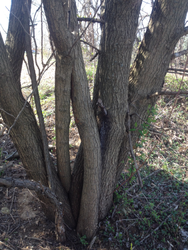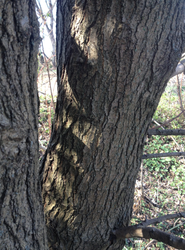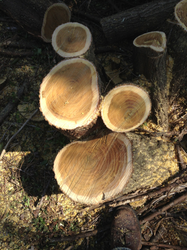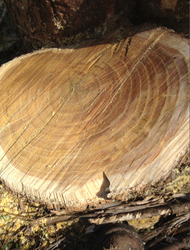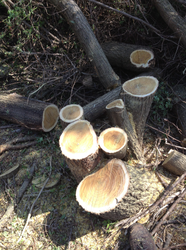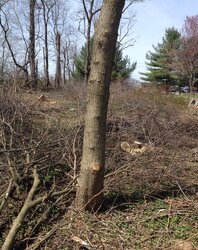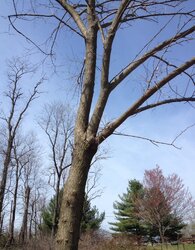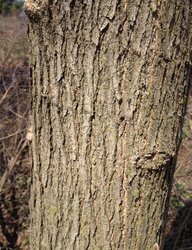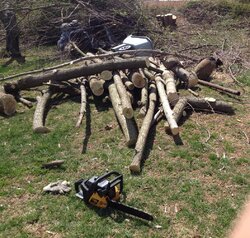wood ID help
- Thread starter Cornflakes
- Start date
-
Active since 1995, Hearth.com is THE place on the internet for free information and advice about wood stoves, pellet stoves and other energy saving equipment.
We strive to provide opinions, articles, discussions and history related to Hearth Products and in a more general sense, energy issues.
We promote the EFFICIENT, RESPONSIBLE, CLEAN and SAFE use of all fuels, whether renewable or fossil.
You are using an out of date browser. It may not display this or other websites correctly.
You should upgrade or use an alternative browser.
You should upgrade or use an alternative browser.
- Status
- Not open for further replies.
Clyde S. Dale
Feeling the Heat
Oldman47
Minister of Fire
Osagebndr
Minister of Fire
mark cline
Minister of Fire
Pennsyltucky Chris
Minister of Fire
Mulberry. I burned it for the first time this past winter. Not as hot as locust IMO, but better than your walnuts, cherrys, soft maples, etc. High mid-range in btus if I had to rate it.
Did you let it season a few years? Its hotter than beech and white oak,
Applesister
Minister of Fire
I think your pictures are fantastic. I was gonna say Hedge because of the trees habit....you know..in a hedgerow.
Too many votes for Mulberry. Is it because Hedge is a brighter yellow?
Too many votes for Mulberry. Is it because Hedge is a brighter yellow?
Applesister
Minister of Fire
It looks like there is growth rings inside of the growth rings. Mulberry produces prolific fruit, I would imagine its slow growing in character with all fruit trees.Is mulberry a fast growing tree? The wide growth rings say so.
That tree is obviously multi stemmed, that isn't characteristic of mulberry, is it?
Woody Stover
Minister of Fire
"All around the Mulberry bush, the monkey chased the weasel..."That tree is obviously multi stemmed, that isn't characteristic of mulberry, is it?

BamaScroungr
Burning Hunk
Is mulberry a fast growing tree? The wide growth rings say so.
Mulberry grows like a weed. I have several young ones coming up in my yard. The bark on my older trees looks similar, but the color is more yellowish. I know there are a few different varieties, though.
Clyde S. Dale
Feeling the Heat
Did you let it season a few years? Its hotter than beech and white oak,
Yup, had been sitting on it for 2 years.
Wood Duck
Minister of Fire
That is either Mulberry or Hedge. Both can grow as a multi-stemmed tree like the one in the picture.
Another vote for Mulberry. Hedge is slower growing with thinner growth rings (at least that is my observance).
Too many votes for Mulberry. Is it because Hedge is a brighter yellow?
All of the mulberry I have cut is really bright yellow when freshly cut or split, but quickly turns a deep brown when sitting in the sun. Quickly as in a day or two.
Makes some serious sparks when stirring the coals.
BamaScroungr
Burning Hunk
Applesister
Minister of Fire
Mulberry had been sold to the British at time of the nursery rhyme. Red mulberry was falsely represented to take the place of white mulberry. White mulberry spread thruout the silk routes of China and Japan. As the single solitary food of silk worms. The process of making silk was closely guarded.
Britain tried and failed but the fruit from Red mulberry became a staple.
There are many cultivars of Red and White and paper mulberry. Also our native Red mulberry. (Which is, apparently, the above mentioned 'bush')
The trees I've seen are cultivars of both White and Red. And there is alot of genetic altering that goes on with a tree with such a famous background.
I did a little study on Mulberry for a friend of mine who had a rather old/large Red growing in her front yard.
Its a tree species with quite a history.
Mulberry (white)was also listed in a book called: 50 Plants that Changed the Course of History. -By Bill Laws A fun read.
The tree in my friends yard has never been cut down.
Britain tried and failed but the fruit from Red mulberry became a staple.
There are many cultivars of Red and White and paper mulberry. Also our native Red mulberry. (Which is, apparently, the above mentioned 'bush')
The trees I've seen are cultivars of both White and Red. And there is alot of genetic altering that goes on with a tree with such a famous background.
I did a little study on Mulberry for a friend of mine who had a rather old/large Red growing in her front yard.
Its a tree species with quite a history.
Mulberry (white)was also listed in a book called: 50 Plants that Changed the Course of History. -By Bill Laws A fun read.
The tree in my friends yard has never been cut down.
Applesister
Minister of Fire
Oldman47
Minister of Fire
Many of my mulberries are multi-trunk ones. All of mine were planted by birds as I imagine is typical for most of us. I will soon know a lot more about mulberry as a fire wood because all but one of mine are on this years list of trees to drop. That one happens to be in a good spot to shade my tool shed and is large enough to be a significant tree for the bird population here.
- Status
- Not open for further replies.
Similar threads
- Replies
- 7
- Views
- 1K


